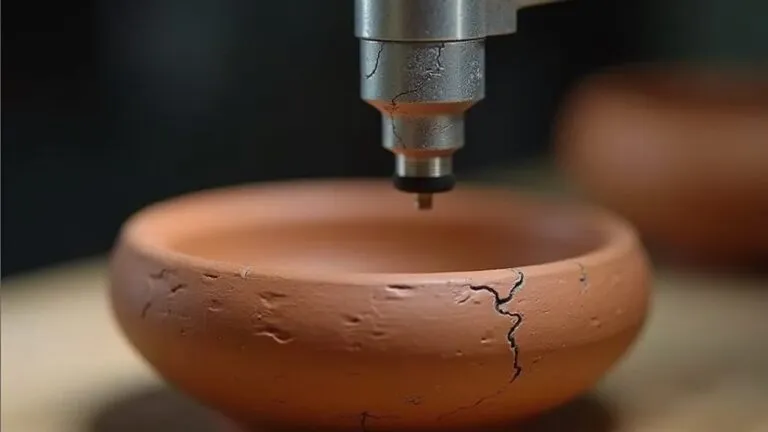To determine if your handmade pottery is food safe, you'll need to check several key factors. First, look for food-safe certification marks like the wine glass and fork symbol (EU) or FDA compliance labels. The pottery should be made from stoneware or porcelain, fired at temperatures above 2,200°F for complete vitrification. Examine the glaze – it should be properly fired, free from crazing or damage, and labeled as dinnerware-safe or bear the AP seal. Avoid pieces with bright red, yellow, or orange glazes, especially in vintage items, as they may contain lead. Watch out for warning labels indicating "Not for Food Use" and grayish residue after washing. There's much more to ensuring your pottery's safety than meets the eye.
Understanding Food Safety Standards

While handmade pottery can add unique charm to your dining experience, understanding food safety standards is essential to protect yourself and your family from potential health risks.
The FDA's food safety regulations provide clear guidelines about what makes pottery safe for your table, and you'll want to pay attention to these rules.
When you're considering handmade ceramics, consumer awareness is your best defense. You should know that the FDA requires warning labels on unsafe pieces, but don't assume unmarked items are automatically safe. Bright colors like yellow, red, and orange often indicate the presence of lead in older pieces.
If you're passionate about artisanal pottery, you'll be glad to know there's a growing movement toward lead-free glazes.
Keep in mind that no amount of cleaning can make unsafe pottery food-safe, so it's worth taking the time to verify safety standards before serving your famous chili in that beautiful handmade bowl.
Identifying Safe Pottery Materials
You'll find that choosing the right materials for food-safe pottery starts with understanding different clay bodies, as stoneware and porcelain offer excellent safety due to their low porosity when fired at high temperatures.
You should avoid using earthenware since its more porous nature makes it less suitable for food contact without proper glazing.
When it comes to glazes, you'll want to select those specifically formulated for food contact and guarantee they're fired to maturity, creating a smooth, non-porous surface that won't trap bacteria or leach chemicals.
The firing temperature plays a vital role in your pottery's safety, so you'll need to maintain temperatures between 2,200°F and 2,400°F for stoneware and porcelain to achieve proper vitrification and food safety.
Clay Types and Properties
When selecting pottery for food use, understanding clay types and their properties is essential for safety. Your clay composition analysis should focus on stoneware and porcelain, as they're typically the safest options due to their high firing temperatures and low porosity.
While earthenware suitability can be achieved, it requires extra attention to guarantee food safety. Proper firing techniques further enhance the safety and durability of pottery pieces.
Here's what you'll want to look for in food-safe clay:
- Insoluble materials that won't break down with food contact
- Non-porous surface after firing to prevent bacterial growth
- Complete vitrification through proper firing temperatures
- Freedom from harmful chemicals like lead and cadmium
You'll find that stoneware and porcelain are your best bets for everyday use, as they're durable and less likely to chip or scratch.
Glazes for Food Use
Selecting food-safe glazes requires careful attention to their chemical composition and application methods.
When you're exploring different glaze types and color variations, you'll want to focus on those specifically labeled as dinnerware-safe or bearing the AP seal. These markings aren't just fancy stickers – they're your assurance that the glazes have passed rigorous safety testing.
High percentages of metal oxides in glazes can be dangerous, as they may leach into food over time.
You'll need to be particularly careful with the inside surfaces of your pottery.
It's best to use transparent or white liner glazes that are known to be food-safe, even if you're experimenting with more creative glazes on the exterior.
Remember, a beautiful glaze that's perfect for decorative pieces mightn't be suitable for your morning coffee mug.
If you're unsure about a glaze's safety, don't hesitate to perform acid tests or seek professional testing.
Safe Firing Temperature Ranges
The proper firing temperature range stands as one of the most critical factors in creating food-safe pottery.
When you're exploring different firing techniques, you'll find that higher temperatures typically result in safer pottery finishes. Here are the key temperature ranges you should know:
- Low-fire (1832-2079°F): Requires food-safe glazing due to porosity
- Mid-fire (2142-2232°F): Perfect for everyday dinnerware
- High-fire (2345-2552°F): Creates exceptionally durable pieces
- Commercial grade (2400°F+): Maximum food safety standard
You'll want to focus on mid to high-fire ranges for the best food-safe results. Stoneware clay excels at these temperatures due to its durability and chip resistance.
These temperatures guarantee your pottery's non-porous nature, making it safe for everything from morning coffee to acidic foods.
Essential Glaze Safety Checks
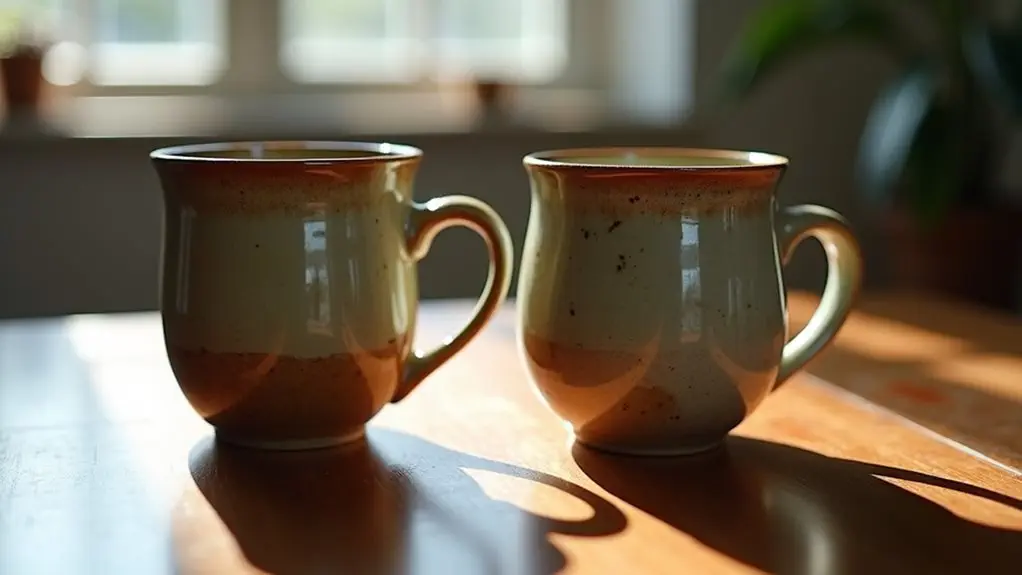
Four critical safety checks help determine if pottery glazes are food-safe.
First, examine your glaze composition carefully – if you're seeing unusually high amounts of lithium carbonate, zinc, or boron, you'll need to adjust your recipe. Commercial glazes should be thoroughly researched for safety testing documentation.
Next, check that your glazes are properly melted and don't have that sparkly crystalline look that might indicate leaching problems.
Don't skip leachability testing – it's your kitchen's best friend!
Try the simple lemon juice or vinegar test by leaving either liquid on your glazed surface overnight. If you notice any color changes or surface deterioration, that's a red flag.
For ultimate peace of mind, consider using tried-and-true materials like frits, ball clay, and feldspar, which have proven safety records in food-safe applications.
Testing for Lead Content
While modern American potters rarely use lead in their glazes, testing for lead content remains essential for ensuring food safety, especially with vintage or imported pieces. Quality control experts emphasize that atomic absorption spectroscopy provides the most accurate analysis for lead detection.
When it comes to pottery regulations and lead testing, you'll want to skip those tempting home test kits – they're notorious for false alarms and weren't designed for ceramics in the first place!
For reliable results, here's what you should do:
- Send samples to a professional testing lab
- Request specific FDA compliance testing
- Ask for ASTM C738-94 standard testing
- Get documentation of test results
Surface and Design Considerations
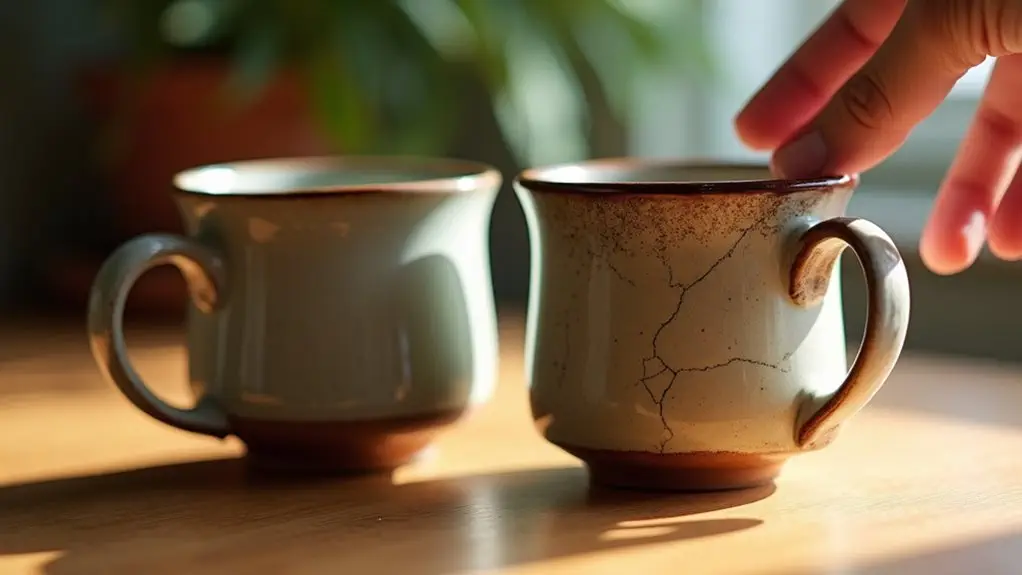
Since bacteria can lurk in even the tiniest crevices, examining a piece's surface texture and design elements is essential for determining food safety.
When you're checking surface smoothness, run your fingers across the pottery – it should feel glassy and free from rough spots or crackling. You'll want to avoid pieces with textured surfaces or complex designs that could trap food particles. Local testing requirements vary significantly between countries, making universal safety standards difficult to establish.
Pay close attention to the glaze characteristics, too. Your pottery should have a well-matured glaze that's waterproof and doesn't show signs of heavy crystallization.
If you're looking at colorful pieces, make sure they've a clear overglaze for added protection. Remember, simpler designs aren't just trendy – they're actually safer for your food!
Look for pieces that are dishwasher-safe and can handle temperature changes without cracking.
Proper Pottery Firing Requirements
To guarantee your pottery is truly food safe, understanding proper firing requirements is absolutely essential. Your firing techniques and kiln maintenance practices will make or break your pottery's safety level.
For optimal results, begin with a bisque firing at 960°C. When you're aiming for food-safe pieces, you'll need to hit specific temperature ranges and follow proper schedules.
Here's what you'll need to achieve for food-safe pottery:
- Fire at temperatures above 2,100°F for complete vitrification
- Maintain consistent temperature throughout the firing process
- Follow a careful cooling schedule to prevent cracking
- Monitor your kiln's performance regularly for best results
Signs of Unsafe Pottery
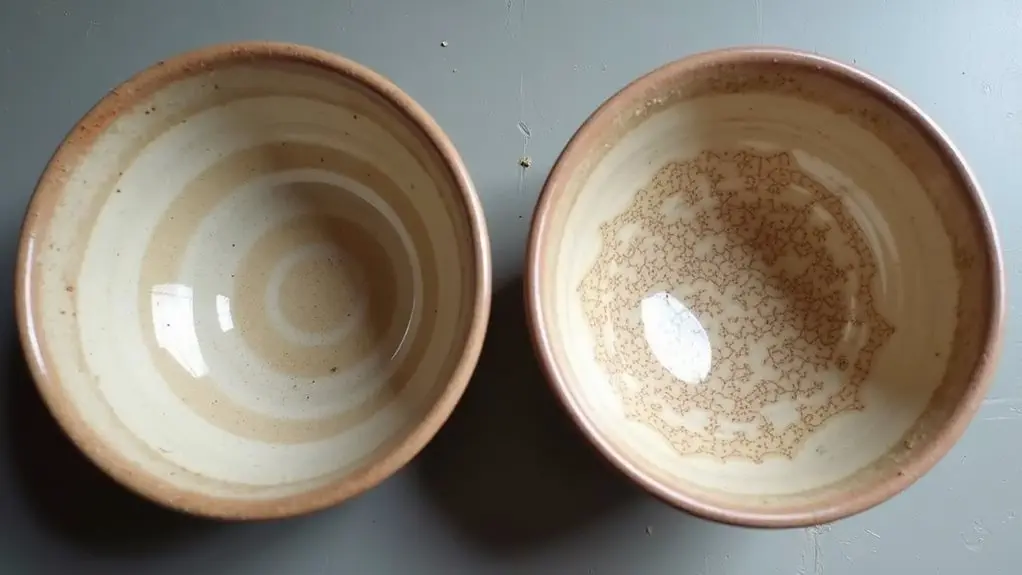
Before using any pottery for food, you'll need to watch for several critical warning signs that indicate unsafe pieces.
When evaluating pottery safety, check for warning labels that say "Not for Food Use" or similar cautions on the bottom – these pieces are definite no-gos.
You'll also want to be wary of pottery materials in brightly colored pieces, especially those with orange, red, or yellow designs, as they might contain lead.
Keep an eye out for damaged glazes, crazing (those tiny cracks in the surface), or any grayish residue after washing. Some glazes contain soluble compounds that can leach into food and cause serious health problems if ingested.
If you're shopping at flea markets or from street vendors, you'll need to be extra cautious since these pieces often haven't been tested for food safety.
When in doubt, grab a lead testing kit – it's better to be safe than sorry!
Manufacturer Certifications That Matter
When shopping for food-safe pottery, three key certification systems can help verify a piece's safety: European Union certifications like MOCA, U.S. FDA regulations, and state-specific requirements like California Prop 65.
With consumer awareness on the rise, certification importance can't be understated. Products produced in Vietri undergo Independent Laboratory testing by the Ministry.
To guarantee you're getting safe pottery, look for these critical certifications:
- The wine glass and fork symbol (EU compliance)
- FDA certification documentation
- Third-party testing lab results
- Declaration of Conformity for glazes
You'll want to check that your pottery manufacturer maintains proper documentation and undergoes regular safety audits.
If you're unsure about a piece's certification status, don't hesitate to contact the manufacturer directly.
Maintenance and Care Guidelines
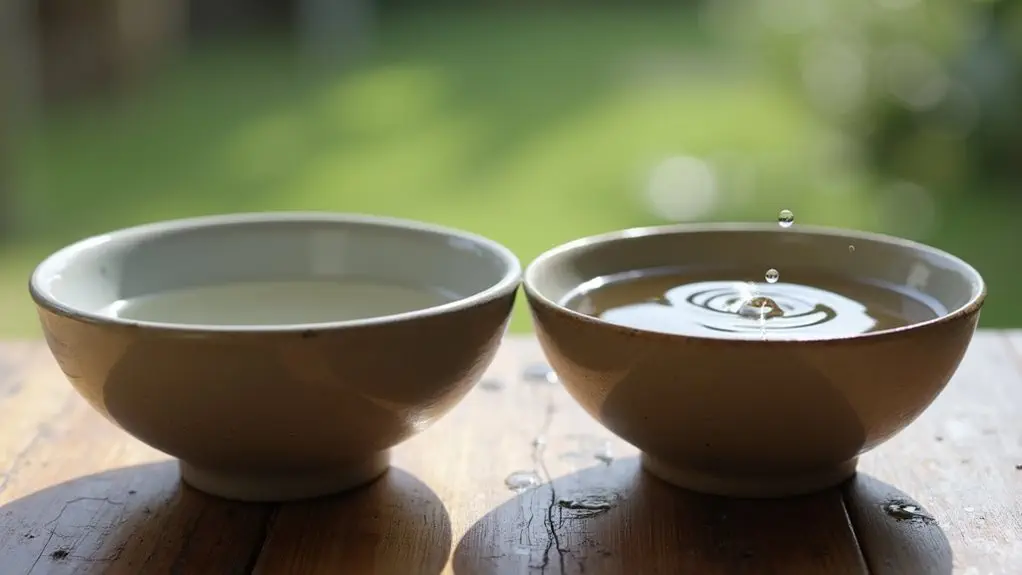
Having certified food-safe pottery is just the starting point – proper maintenance guarantees your pieces remain safe and beautiful for years to come.
You'll want to master essential pottery cleaning techniques that protect both the glaze and clay body. Start by hand washing your pieces with warm, soapy water and a soft sponge, steering clear of harsh detergents that could damage the surface. A mixture of baking soda paste can effectively remove stubborn stains.
Here's a key glaze maintenance tip: avoid exposing your pottery to extreme temperature changes. Don't move pieces straight from the fridge to the microwave – you're just asking for cracks!
If you notice any mildew developing, soak your pottery overnight in a sanitizing solution. Remember to thoroughly dry each piece after washing, especially if you live in a humid climate.
These simple steps will keep your handmade treasures food-safe and looking fantastic.
Safe Usage Best Practices
Safe usage of handmade pottery requires understanding both material limitations and proper handling techniques.
You'll want to develop smart habits for safe cleaning and proper storage to guarantee your pieces remain beautiful and functional for years to come. Handmade pieces crafted from high-quality porcelain often provide a safer option for food use.
Checking your pieces regularly for glaze integrity stability is vital since compromised glazes can leach harmful substances into food.
Here are the essential steps you'll need to follow:
- Always inspect your pottery for chips or cracks before each use.
- Store pieces separately to prevent scratching and damage.
- Use gentle, non-abrasive cleaners for washing.
- Allow pieces to dry completely before stacking or storing.
Remember that different types of pottery have unique needs.
If you're using pieces for acidic foods like tomato sauce or citrus, don't store these items in the pottery long-term.
For everyday use, it's best to stick with well-glazed stoneware or porcelain that's been properly fired and tested for food safety.
Final Thoughts
When it comes to handmade pottery safety, you'll want to treat your research like a detective solving a delicious mystery. By checking for proper materials, testing for lead, examining glazes, and looking for safety certifications, you're well-equipped to make informed decisions about your pottery pieces. Remember, with proper care and attention to these guidelines, you can safely enjoy your beautiful handmade ceramics for years to come.



